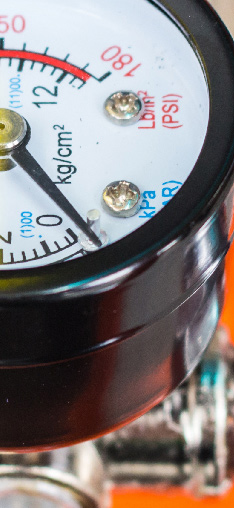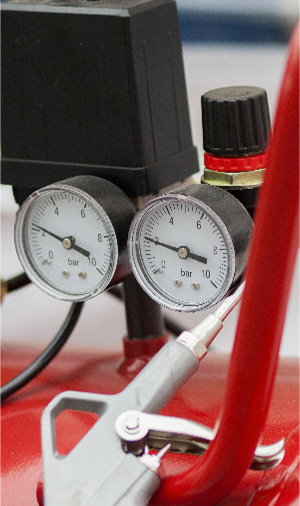How To Choose The Right Air Compressor
Post By: Ryan King On: 04-03-2021 Read Time: 7 minutes - Guides - Pneumatics
Post By: Ryan King On: 04-03-2021 Read Time: 7 minutes - Guides - Pneumatics
An air compressor is the power source for all kinds of pneumatically operated tools, whether that's a hand-held spray gun or a fully automated industrial complex. Air is a clean and affordable energy source, and many industrial processes are switching from mechanical and fossil-fuel driven automation to pneumatics.
A standard air compressor works by converting static electrical energy into kinetic fluid power. This involves using a motor to run the compressor, which usually contains a piston (or some other form of mechanical device) that forces the air into a smaller volume of space. There are also compressors that generate air pressure by means of rotating vanes, but this type is far less common than the piston type, or positive-displacement compressor.

A conventional piston compressor is something like your car's internal combustion engine. The piston has a crankshaft and a connecting rod that are driven by the motor. The piston is mounted inside a cylinder, which also contains a valve head holding the air inlet and discharge valves. These are just thin metal flaps mounted above and beneath a valve plate, which open and close to let air in and push it out. The downward movement of the piston creates a vacuum above the valve plate, drawing in external ambient air, which pushes the inlet valve open to fill the vacuum. The upward movement of the piston compresses the air above the valve plate, keeping the inlet valve closed and forcing open the discharge valve.
Most compressors have a storage tank holding a quantity of air which has been compressed to a preset pressure range. The discharged compressed air moves into the tank through an outlet port in the compressor, and its pressure rises as more air
How much pressure you need depends on what you're using it for, so most compressor assemblies will include a regulator that can be set up according to the pressure requirements of your application. Gauges mounted before and after the regulator unit monitor the tank and air line pressure, and there's a safety valve in case the pressure switch malfunctions.
Your application will also determine the size of your compressor, as obviously a full-scale industrial plant is going to need a greater capacity than an air line for your DIY jobs in the garage. If the compressor is for home use, you'll still need to determine the size of the tank according to the scale and purpose of your project. Airbrushing home ceramics and inflating tyres require a lot less capacity than home improvements or construction. Some pneumatic tools, e.g. sanders and grinders, demand a constant airflow, and that will require an air compressor with more airflow capacity and hence a bigger tank.
Choosing your compressor also depends on your available power source, with larger compressors requiring a greater voltage supply than is provided by a standard domestic outlet. Using electricity to run your air compressor does limit your choice of working environment, as you always need to set up your rig near a mains power outlet. The alternative is to choose a compressor driven by petrol or diesel fuel. This provides total flexibility, and you can set up your project anywhere.
If you're working in the same place all the time, you need to choose a compressor that fits into your available space, as large air storage tanks take up a lot of room. A static compressor is fine for a workshop or garage, but you might need a portable air compressor if you need to move around a lot. In this case, you need one with wheels, or one that's lightweight and comfortable to carry.
One of the main considerations in knowing how to choose the right compressor is working out how much air you will actually need to run your application. This requires a calculation which is typically given as either Cubic Feet per Minute (CFM), or Litres per Minute (L/Min). Air tools are usually rated by the manufacturer, and this is commonly based on a 25% duty cycle (which means it's only actually active for 15 of every 60 seconds). For continuous use tools (i.e. those active 60 out of 60 seconds), you'll therefore have to multiply the CFM rating by 4.
Commonly used air tools operating at 90-150psi include such items as staple guns, impact wrenches, air hammers, grease guns and riveters. These will have a CFM rating of between 2 and 4, while sanders, grinders and spray guns are much higher. To convert the CFM rating to a measurement of L/Min, you can use our calculator to the right. Note that the CFM rating is usually based on operating pressure of 90psi, so you should factor any changes from this pressure range into your calculations.
| Cubic Feet Per Minute (CFM) | Litres Per Minute (L/Min) |
|---|---|
| 1 | 28.3168466 |
| 0.0353147 | 1 |

The tanks for an air compressor come in a range of sizes, starting at six litres and expanding to 500 litres or more. The capacity of the tank determines how long you can run your air tools before the motor has to cycle on for the compressor to provide more compressed air. The less often this happens, the longer your motor will last. The horsepower (HP) of the compressor's motor is a further consideration in how to choose the right air compressor, as the more power it has (or the higher HP), the faster it will work to fill up your tank.
The size of the tank will also affect the performance of your compressor, and how much time it's actually in use. If you try to blow up a bouncy castle with a balloon pump, for example, you'd still be there when your family have left for another party. If you use an air pump, a powerful motor and a compressor with a 500-litre tank, you’ll be ready to get on with firing up the barbie before the guests arrive.
As a rough guide, you can estimate the minimum tank size required for the compressor by multiplying the CFM of your air tool by six. For example, if you want to use a staple gun rated at 2 CFM, you'll need a tank that holds at least 12 litres of compressed air. Don't forget those air tools that require a continuous airflow, because they need a larger tank to provide that air than those tools operating only in short bursts, like nail guns.
A final consideration in how to choose the right air compressor is whether you go for one with or without oil. A standard oil-lubricated compressor will generally run more quietly and produce a higher output, but there are some drawbacks. The typical positive-displacement compressor uses oil to lubricate the moving parts. There’s an oil reservoir that lubricates the cylinder walls and bearings by splashing the oil on them as the crankshaft rotates. The pistons have piston rings designed to keep the lubricating oil separate from the compressed air, though some oil particles in aerosol form will inevitably get into the downstream air.
This doesn't have to be a problem, as most air tools will need oiling anyway, and many of them have inline oilers added to the tool to increase a uniform oil supply. On the other hand, air tools with inline oilers must be sited on a level surface for effective operation (to prevent leaks), as well as requiring regular oil inspections and periodic oil changes.
More importantly, there are some tools and operational environments that demand the compressed air be oil-free. If any oil is present in the airstream when spray painting, for example, it will cause problems with the finish. There are also new air tools on the market designed for woodworking, such as sanders and nailers, which are designed to be oil-free (by using materials such as Teflon). Getting oil on wooden surfaces creates significant and costly problems, so if you're looking for cabinetry or carpentry applications, then oil-free is the way forward.
There are other solutions available to solve the problem of airborne oil, such as using an oil filter or separator in the air line. An oil-free compressor is a better long-term solution, because it replaces the oil bath design with permanently lubricated bearings. An oil-free compressor is likely to cost a lot less, weigh less and require less maintenance, but may have a shorter lifespan because the bearings will dry out.
Knowing how to choose the right compressor depends on a number of variable factors, including power supply, available space, capacity and cost. There are compressors for every job, so context is the deciding factor.